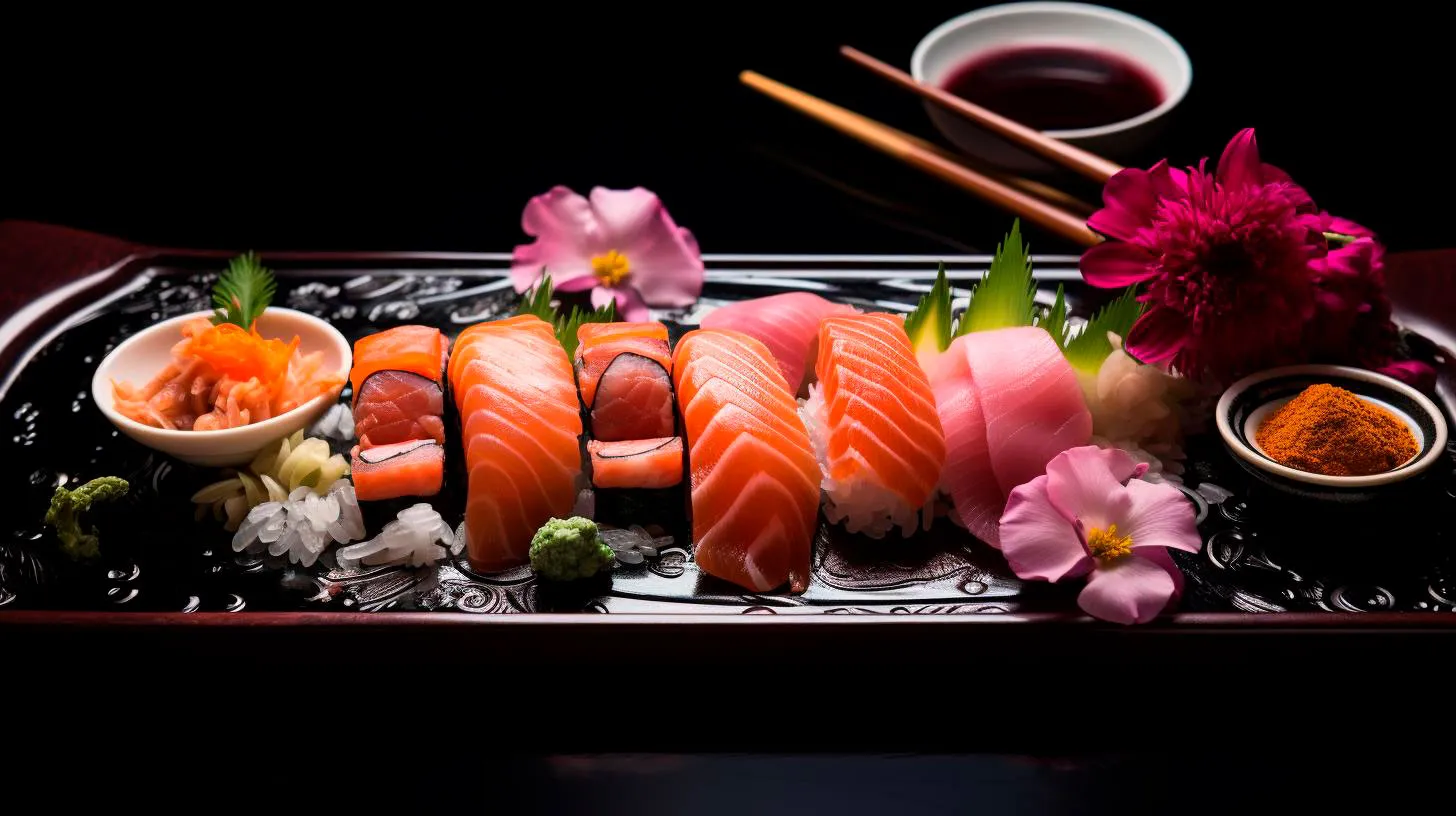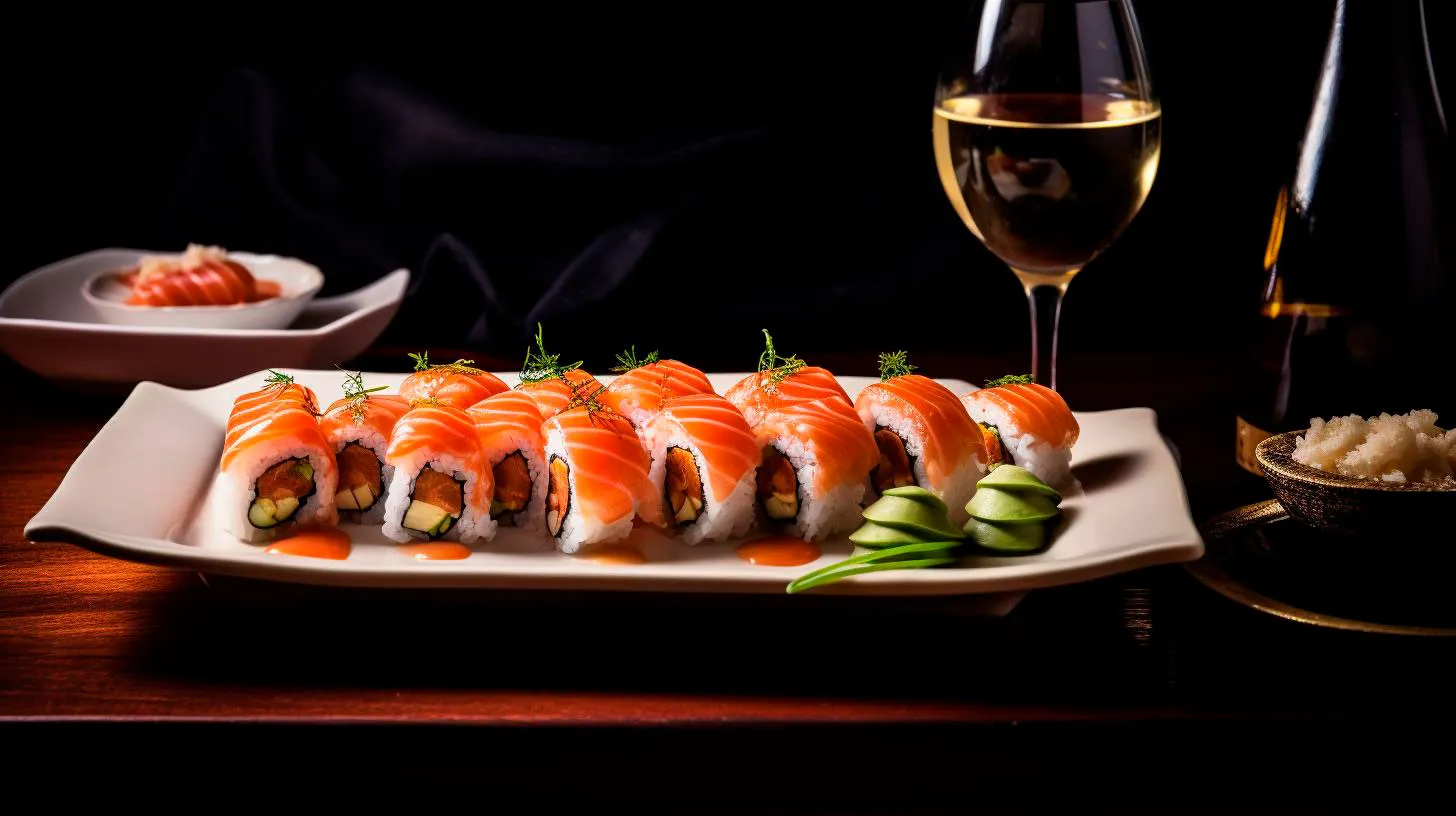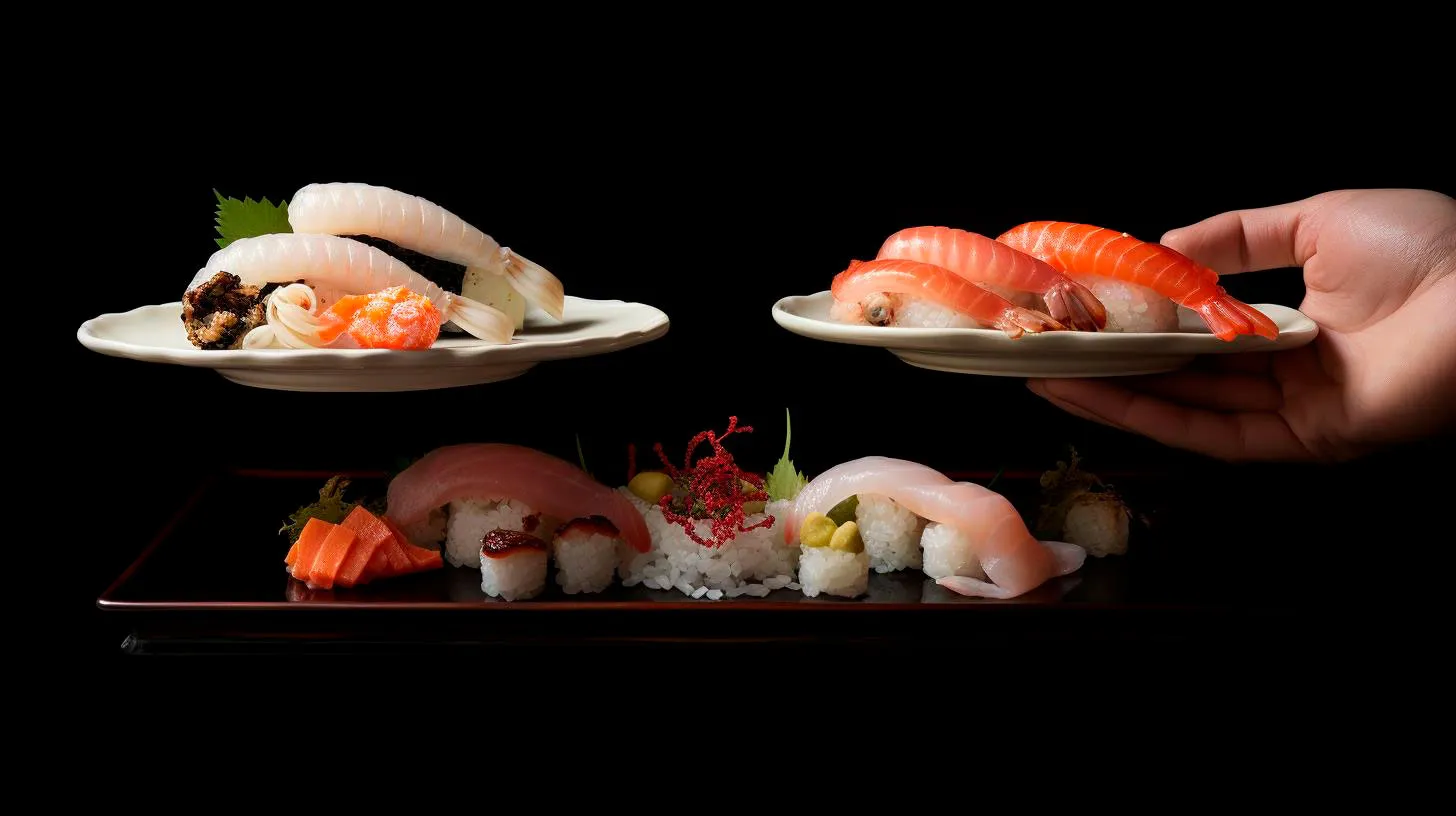Exploring the Evolution of Sushi Techniques and Ingredients
In this article, we will delve into the fascinating journey of sushi, exploring its transformation and the key ingredients and techniques that have shaped its evolution.
The Beginnings of Sushi
The roots of sushi can be traced back to ancient Southeast Asia, where preserved fish was wrapped in fermenting rice. This method was developed to preserve the fish and improve its taste. As this technique made its way to Japan around the 8th century, it underwent significant changes to adapt to the local culture and preferences.
Initially known as nare-zushi, this sushi variation featured fish and rice packed together and stored for months to achieve fermentation. Popular during the Muromachi period (1336-1573), this style allowed the fish to be consumed at any time, even during times of limited supply.
The Rise of Edo-Mae Sushi
While nare-zushi was prevalent for centuries, it was during the Edo period (1603-1868) that the sushi we know today began to take shape. Known as Edo-mae sushi, it was developed as a fast food option in the bustling city of Edo (now Tokyo).
Edo-mae sushi introduced new techniques that revolutionized the art of sushi preparation. Vinegar was now used to preserve the fish without the need for fermentation, resulting in a fresher and more flavorful dish. Additionally, raw fish slices were now placed on bite-sized portions of rice, making it convenient to eat with hands.
The use of wasabi, soy sauce, and pickled ginger also became widespread during this period, enhancing the overall taste and experience of sushi. Diners could now customize the flavor profile according to their preferences.
Modern Sushi Techniques
As sushi gained popularity worldwide, it continued to evolve, adapting to different cultures and tastes. Modern sushi techniques have elevated the art form, ensuring that it remains a beloved delicacy in the international culinary scene.
Sushi Rolls – Maki and Temaki
A notable adaptation of sushi is the introduction of rolls, known as maki and temaki. Maki rolls involve wrapping rice, fish, and vegetables in a sheet of nori seaweed and slicing them into bite-sized pieces. Temaki, on the other hand, is a hand-rolled cone-shaped sushi. These techniques allow for endless variations, enabling chefs to incorporate various ingredients and flavors and giving diners a more diverse sushi experience.
- Key takeaway: Maki and temaki rolls offer a versatile and creative way to enjoy sushi. The variety of fillings and flavors ensures a unique dining experience every time.
Nigiri – A Showcase of Skill and Freshness
Nigiri sushi showcases the skill of the sushi chef and the freshness of the ingredients. Nigiri consists of a small mound of rice topped with a slice of raw fish or seafood. The chef must expertly shape the rice and delicately place the fish to achieve the perfect balance of flavors and textures.
- Key takeaway: Nigiri sushi highlights the mastery of sushi chefs and provides an authentic taste experience. Freshness and attention to detail are essential for the best nigiri sushi.
Sashimi – The Ultimate Raw Delight
Sashimi, while technically not sushi as it doesn’t include rice, is an integral part of the modern sushi experience. It showcases the quality and freshness of raw fish and seafood. Sashimi is often served as a standalone dish or alongside sushi, allowing diners to fully appreciate the natural flavors of the ingredients.
- Key takeaway: Sashimi provides a pure and unadulterated taste of raw fish and seafood. Its exquisite flavors highlight the importance of selecting the freshest ingredients.
The Rediscovery of Traditional Ingredients
Despite the constant innovation in sushi techniques, traditional ingredients remain at the heart of this beloved cuisine. The exploration of sushi has led to a rediscovery of local ingredients and their fusion with the traditional sushi-making process.
Seasonal and locally sourced fish and vegetables are now given more importance in sushi. Chefs and diners appreciate the variety of flavors and textures these ingredients bring to the table, highlighting the importance of sustainability and supporting local producers.
The Future of Sushi
As sushi continues to grow in popularity, the future of this culinary art form looks promising. Chefs are continuously pushing boundaries, experimenting with new ingredients and techniques to create extraordinary sushi experiences.
Advancements in technology have also made sushi more accessible. The rise of conveyor belt sushi, where plates of sushi circulate around a restaurant, allows diners to explore a variety of sushi options conveniently.
With the increasing focus on sustainability and environmental impact, future developments in sushi may include alternative ingredients and eco-friendly practices. Chefs and researchers are exploring plant-based and lab-grown seafood options, ensuring that sushi can be enjoyed while minimizing its impact on the planet.
Conclusion
Sushi’s journey from its humble beginnings to a global culinary sensation is a testament to its ability to adapt and innovate. The evolution of techniques, introduction of new ingredients, and fusion with international flavors have brought sushi to new heights.
Whether you prefer the traditional nigiri, the creative maki rolls, or the luxurious sashimi, sushi offers a dining experience that combines simplicity, elegance, and endless possibilities.
Sushi Fusion: Integrating Western Influences into Traditional Japanese Cuisine
In this article, we will explore the concept of sushi fusion, its advantages, and key takeaways.
The Rise of Sushi Fusion
Sushi fusion is the art of blending traditional Japanese sushi-making techniques with Western ingredients, flavors, and presentation styles. This culinary trend emerged as a response to the growing demand for innovative flavors and diverse dining experiences. By incorporating elements from Western cuisine, sushi fusion has transformed this traditional Japanese dish into a global sensation.
Key Takeaway: Sushi fusion offers a modern twist to traditional Japanese cuisine, keeping it relevant and appealing to a wider audience.
The Advantages of Sushi Fusion
1. Expanded Flavor Profiles: Sushi fusion introduces a myriad of exciting flavor combinations, allowing chefs to experiment with unique ingredients such as cream cheese, avocado, and even fruits like mango and strawberry.
2. Accessibility: By incorporating Western ingredients, sushi fusion caters to a broader range of dietary preferences and restrictions, ensuring that there is something for everyone, including vegetarians and those with gluten sensitivities.
3. Enhanced Presentation: Western influences have revolutionized the presentation of sushi, transforming it into a visually appealing culinary art form. Chefs now play with vibrant colors, shapes, and textures, resulting in stunning sushi compositions.
4. Innovation and Creativity: Sushi fusion encourages chefs to push boundaries and experiment with bold flavor combinations, creating unique rolls and dishes that wow diners and keep them coming back for more.
5. Global Popularity: Thanks to the incorporation of Western influences, sushi fusion has gained widespread popularity across the globe. It has become a symbol of how different flavors and cultures can seamlessly blend together.
Examples of Sushi Fusion Creations
1. The California Roll: Perhaps the most well-known sushi fusion creation, the California roll originated in Los Angeles in the 1960s. It combines avocado, crab meat, and cucumber, rolled with seaweed and rice. This variation substituted traditional raw fish with cooked ingredients to suit the preferences of Western diners.
2. The Tempura Roll: Tempura, a popular Japanese cooking technique involving deep-frying batter-coated ingredients, has been integrated into sushi rolls. The tempura roll typically consists of lightly battered shrimp or vegetables, providing a delightful crunch.
3. The Spicy Tuna Roll: This iconic sushi fusion creation features a mixture of raw tuna mixed with spicy mayonnaise sauce, rolled with rice and seaweed. Western taste buds influenced the addition of spice, enhancing the flavor profile of traditional sushi rolls.
4. Sushi Burritos: Taking inspiration from Mexican cuisine, sushi burritos combine the convenience of handheld burritos with the flavors and ingredients of sushi. They typically consist of sushi rice, fresh fish, vegetables, and various sauces, all wrapped in a large sheet of seaweed.
Key Takeaways
- Sushi fusion infuses traditional Japanese cuisine with exciting Western flavors and ingredients.
- It expands flavor profiles and caters to a wider range of dietary preferences.
- Enhanced presentation and visually appealing sushi compositions are a result of Western influences.
- Sushi fusion encourages innovation, creativity, and experimentation.
- Examples of sushi fusion creations include the California roll, tempura roll, the spicy tuna roll, and sushi burritos.
Sushi fusion has revitalized the traditional Japanese culinary scene, introducing a fresh and innovative perspective to sushi. By integrating Western influences, chefs have expanded the flavor horizons, making it accessible to a diverse range of tastes and preferences. This fusion has not only propelled sushi’s popularity globally but also pushed the boundaries of culinary creativity. So, the next time you dine at a sushi restaurant, be prepared to embark on a delightful journey of flavors, where tradition meets innovation.
The Rise of Sushi as a Global Culinary Phenomenon
The Global Sushi Craze
In recent years, sushi has become increasingly popular in countries far beyond Japan. Its rise in popularity can be attributed to several factors:
- Health Consciousness: With the growing emphasis on health and wellness, sushi offers a nutritious and low-calorie option. It is rich in omega-3 fatty acids, high-quality proteins, and essential vitamins.
- Adventurous Palates: As people become more open to trying new flavors and cuisines, sushi presents an exciting and unique dining experience.
- Globalization: The interconnectedness of the world has fueled the spread of sushi. As travel and cultural exchange increase, so does the demand for diverse culinary experiences.
Sushi has not only transcended cultural boundaries but also adapted to local tastes and preferences. In different parts of the world, sushi has taken on unique variations and fusion with local flavors.
The Benefits of Sushi
Aside from its incredible taste, sushi offers numerous health benefits:
- Heart-Healthy: The omega-3 fatty acids found in fish, such as salmon and tuna, are known to reduce the risk of heart disease and lower blood pressure.
- Weight Management: Sushi is a great option for those looking to maintain or lose weight. With its low-calorie content, it provides a satisfying meal without excessive caloric intake.
- Rich in Nutrients: Sushi is packed with essential nutrients like protein, vitamins, and minerals, contributing to overall well-being.
Beyond its health benefits, sushi’s artistic presentation also adds to its allure. The skilled craftsmanship involved in preparing sushi showcases the creativity and attention to detail of the sushi chef.
The Cultural Significance
Sushi’s popularity extends beyond its culinary appeal. It carries a rich cultural significance rooted in Japanese traditions:
- Japanese Mastery: Sushi-making is considered an art form in Japan, and sushi chefs undergo years of rigorous training to perfect their skills.
- Symbolism: In Japanese culture, the art of sushi represents harmony, balance, and respect for nature. Every ingredient is chosen carefully to create a harmonious blend of flavors.
- Etiquette: Sushi dining etiquette reflects the importance of respect. Following traditions such as not rubbing chopsticks together or dipping sushi rice-side down in soy sauce demonstrates respect for the chef’s craftsmanship.
The cultural experience surrounding sushi has inspired many enthusiasts to delve deeper into Japanese traditions and customs.
Key Takeaways
Sushi’s global rise can be attributed to its health benefits, cultural significance, and the growing desire for culinary diversity. Here are some key takeaways:
- Healthy Option: Sushi offers a nutritious and low-calorie choice for health-conscious individuals.
- Cross-Cultural Adaptation: Sushi has successfully adapted to local tastes and preferences around the world, resulting in unique variations.
- Artistic Presentation: Sushi’s meticulous presentation showcases the creativity and mastery of sushi chefs.
- Symbolism and Tradition: Sushi carries cultural symbolism, representing Japanese values of harmony, balance, and respect.
- Culinary Exploration: The popularity of sushi has sparked a curiosity for Japanese culture, traditions, and etiquette.
The rise of sushi as a global culinary phenomenon not only demonstrates the power of food to transcend borders but also highlights the importance of cultural appreciation and diversity in today’s interconnected world.
Sushi: A Symbol of Cultural Identity and Heritage
The Cultural Significance of Sushi
Sushi embodies the essence of Japanese culture, serving as a powerful symbol of its identity and heritage. Here are some key factors that make sushi an integral part of Japanese tradition:
- Centuries-old tradition: Sushi has been consumed in Japan for over 1,300 years and has deep roots in the country’s history.
- Attention to detail: Sushi preparation requires precision, balance, and meticulous attention to detail, reflecting the Japanese principles of craftsmanship.
- Seasonality: Ingredients used in sushi vary with the seasons, showcasing the Japanese appreciation for fresh and seasonal produce.
- Social significance: The act of sharing sushi is a social ritual that promotes bonding and camaraderie.
The Health Benefits of Sushi
Sushi not only delights the taste buds but also offers a range of health benefits. Here are a few advantages of incorporating sushi into your diet:
- High-quality protein: Sushi is typically made with fresh fish, which is an excellent source of high-quality protein, essential for muscle growth and repair.
- Omega-3 fatty acids: Fish such as salmon and tuna used in sushi are rich in omega-3 fatty acids, known to promote heart health and reduce the risk of chronic diseases.
- Low in saturated fats: Sushi avoids the use of excessive oil and saturated fats, making it a healthier alternative to many other types of cuisine.
- Rich in vitamins and minerals: The inclusion of vegetables like seaweed, cucumber, and avocado ensures that sushi provides a good dose of essential vitamins and minerals.
The Evolving Variations of Sushi
As sushi has traveled beyond its homeland, it has undergone various adaptations. Chefs from different cultures have infused their own flavors and ingredients, resulting in a wide array of sushi variations. Here are some notable types of sushi:
1. Nigiri
Nigiri sushi consists of a small mound of seasoned rice topped with a slice of fresh fish or seafood. It allows the natural flavors of the fish to shine, capturing the essence of simplicity and elegance.
2. Maki
Maki rolls are created by wrapping sushi rice and various ingredients in a sheet of seaweed (nori) and then slicing it into bite-sized pieces. These rolls can include both raw and cooked ingredients, providing a versatile and customizable sushi experience.
3. Temaki
Temaki, also known as hand rolls, are cone-shaped sushi rolls wrapped in nori. They typically contain a combination of rice, fish, vegetables, and sauces. Temaki offers a fun and interactive way to enjoy sushi without the need for chopsticks.
4. Sashimi
Sashimi is a type of sushi that consists solely of thinly sliced, fresh, and raw fish. It is often served as an appetizer and allows the pure taste of the fish to be savored.
Key Takeaways
Sushi represents more than just a delightful culinary experience. It is a symbol of cultural identity, craftsmanship, and the art of simplicity. As sushi continues to gain popularity across the globe, it brings people together, transcending cultural boundaries.
Remember these key takeaways:
- Sushi is deeply rooted in Japanese tradition, reflecting centuries of craftsmanship and attention to detail.
- Include sushi in your diet for its high-quality protein, omega-3 fatty acids, and essential vitamins and minerals.
- Explore the diverse variations of sushi, such as nigiri, maki, temaki, and sashimi, to discover new flavors and experiences.
So, the next time you indulge in a plate of sushi, savor not just the flavors but also the cultural significance and heritage it represents.



